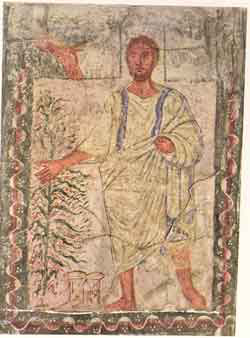Moses the son of Amram; Moses our teacher; the lord of all prophets - leader, liberator, legislator, guide, chief justice, Israel's link with God. All these and more are aspects of Moses’ job description in the Bible and in post-biblical traditions relating to him. Without a doubt he is one of the most popular subjects of biblical art.
Below we will survey some of the artwork depicting parts of Moses’ life and for each one, we will ask the question: who is Moses and what is his character?
The Birth and Rescue of Moses
The wall paintings in the Dura Europos Synagogue, dating from the 3rd century CE, focus primarily on God’s redeeming hand in the Bible’s stories. This focus apparently reflected the community’s hope that the redemption of the Jewish people, even if delayed, would surely come.
Moses appears in at least five of the Dura Europos paintings. This one illustrates the story of his miraculous survival as an infant. The account appears in Exodus 2, after the description of the enslavement of the Israelites by a “new king… who did not know Joseph” (1:8). The text then moves from the general to the specific; likewise, the painting in Dura Europos is a progression divided into three scenes by curtains draped above the characters.

Dura Europos, Rescue of Moses
On the right, fortifications and an open gate represent Egypt, from which the children of Israel will leave; beside them sits the king of Egypt, dressed in the style of the Persian nobles who ruled over the Jews of Dura. Aides flank the king and write down his commands:
(כב) וַיְצַ֣ו פַּרְעֹ֔ה לְכׇל־עַמּ֖וֹ לֵאמֹ֑ר כׇּל־הַבֵּ֣ן הַיִּלּ֗וֹד הַיְאֹ֙רָה֙ תַּשְׁלִיכֻ֔הוּ וְכׇל־הַבַּ֖ת תְּחַיּֽוּן׃ {פ}
(22) Then Pharaoh charged all his people, saying, “Every boy that is born you shall throw into the Nile, but let every girl live.”
In the center, beneath the second curtain, two women stand, gesturing in response to the king's aide, while another woman, her hair exposed, crouches at their feet. Because the painting was damaged, it is hard to see that this woman is placing a cradle in the Nile – this is Jochebed, the mother of Moses and the scene is described in Exodus 2:3. The two other women are either the midwives (Exodus 1:15-21) or Jochebed and Miriam; according to the Midrash, these pairs of characters are actually identical!
At the left, in the widest section of the painting, three women stand with washing utensils in their hands – they are certainly the maidservants of Pharaoh’s daughter since they are dressed differently than Miriam and Jochebed, who appear again on the left edge holding a baby. And finally, below, a cradle floats on the Nile, while a naked woman standing in the river holds a baby. Who is this woman?
In Jewish commentaries and Midrashim on Exodus 2 we find two different responses to the question, Who is drawing Moses out of the water? Both are derived from interpretations of Exodus 2:5:
(ה) וַתֵּ֤רֶד בַּת־פַּרְעֹה֙ לִרְחֹ֣ץ עַל־הַיְאֹ֔ר וְנַעֲרֹתֶ֥יהָ הֹלְכֹ֖ת עַל־יַ֣ד הַיְאֹ֑ר וַתֵּ֤רֶא אֶת־הַתֵּבָה֙ בְּת֣וֹךְ הַסּ֔וּף וַתִּשְׁלַ֥ח אֶת־אֲמָתָ֖הּ וַתִּקָּחֶֽהָ׃
(5) The daughter of Pharaoh came down to bathe in the Nile, while her maidens walked along the Nile. She spied the basket among the reeds and sent her slave girl to fetch it.
By painting her with a necklace, the Dura Europos artist seems to indicate that it was Pharaoh’s daughter herself who rescued Moses.
The emphasis on the figure of Moses in Dura Europos is surely an example of the synagogue's art as an expression of the Jewish people’s hope for redemption. The story of the miraculous rescue of the infant Moses, who is pulled out of the Nile by none other Pharaoh’s daughter herself, is, thus, particularly fitting.
Moses and Aaron
From the outset of his mission, Moses is given a partner, his brother Aaron. Aaron's role appears in Moses’ call prophecy, the vision of the burning bush:
(10) But Moses said to יהוה, “Please, O my lord, I have never been a man of words, either in times past or now that You have spoken to Your servant; I am slow of speech and slow of tongue.” (11) And יהוה said to him, “Who gives humans speech? Who makes them dumb or deaf, seeing or blind? Is it not I, יהוה ? (12) Now go, and I will be with you as you speak and will instruct you what to say.” (13) But he said, “Please, O my lord, make someone else Your agent.” (14) יהוה became angry with Moses and said, “There is your brother Aaron the Levite. He, I know, speaks readily. Even now he is setting out to meet you, and he will be happy to see you. (15) You shall speak to him and put the words in his mouth—I will be with you and with him as you speak, and tell both of you what to do— (16) and he shall speak for you to the people. Thus he shall serve as your spokesman, with you playing the role of God to him.
According to this text, Aaron’s role is to be Moses’ spokesman, a role created due to Moses’ lack of rhetorical skill or perhaps his speech impediment. And indeed, later on, in Exodus 4:12, Aaron accompanies Moses, addressing the children of Israel and Pharaoh.
But the better-known role of Aaron and of his descendants throughout the generations is that of the High Priest.
And now take to you your brother Aaron and his sons with him from among the children of Israel, that he may minister to me in the priest’s office, Aaron, and Nadab and Abihu, Elazar and Itamar, the sons of Aaron.
(א) וְאַתָּ֡ה הַקְרֵ֣ב אֵלֶ֩יךָ֩ אֶת־אַהֲרֹ֨ן אָחִ֜יךָ וְאֶת־בָּנָ֣יו אִתּ֗וֹ מִתּ֛וֹךְ בְּנֵ֥י יִשְׂרָאֵ֖ל לְכַהֲנוֹ־לִ֑י אַהֲרֹ֕ן נָדָ֧ב וַאֲבִיה֛וּא אֶלְעָזָ֥ר וְאִיתָמָ֖ר בְּנֵ֥י אַהֲרֹֽן׃ (ב) וְעָשִׂ֥יתָ בִגְדֵי־קֹ֖דֶשׁ לְאַהֲרֹ֣ן אָחִ֑יךָ לְכָב֖וֹד וּלְתִפְאָֽרֶת׃
(1) You shall bring forward your brother Aaron, with his sons, from among the Israelites, to serve Me as priests: Aaron, Nadab and Abihu, Eleazar and Ithamar, the sons of Aaron. (2) Make sacral vestments for your brother Aaron, for dignity and adornment.
Other texts stress that the exclusivity of this position:
(י) וְאֶת־אַהֲרֹ֤ן וְאֶת־בָּנָיו֙ תִּפְקֹ֔ד וְשָׁמְר֖וּ אֶת־כְּהֻנָּתָ֑ם וְהַזָּ֥ר הַקָּרֵ֖ב יוּמָֽת׃ {פ}
(10) You shall make Aaron and his sons responsible for observing their priestly duties; and any outsider who encroaches shall be put to death.
These two roles, spokesman and priest, are reflected in the two artworks below.
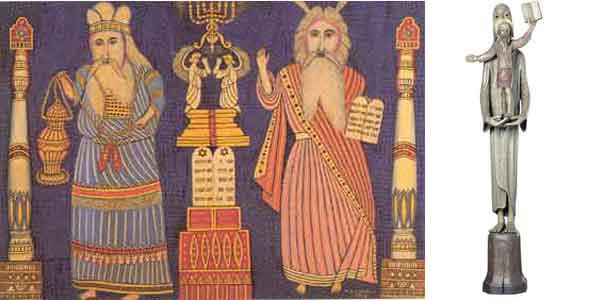
A comparison of these two images highlights the clear differences between them, not only regarding Aaron’s roles, but also in the artists’ understandings of the relationship between Moses and Aaron. On the left, American Jewish folk artist, Morris Hirshfield depicts Moses and Aaron as equal in height and each one occupies an equal space. Moses, who has rays of light emanating from his head, holds the Tablets; Aaron is dressed in the priestly garments and holds a censer – and between them stands the Ark of the Covenant, whose two bowing cherubs mirror the two brothers who work together: Moses in the legal domain and Aaron in the ritual domain. On the right, the Finnish sculptor Hans Autere depicts Moses and Aaron as a single column, long and narrow, with the larger Moses standing behind the smaller Aaron, who is waving a book. On the one hand, Aaron’s head is concealing Moses’ mouth; on the other hand, Moses holds Aaron in his palms. The relationship between the two figures is therefore similar to that between a puppet and its ventriloquist; the role of Aaron as spokesman is merely for appearance.
Moses and Bezalel
Another character who appears in Exodus as a partner of Moses is Bezalel the son of Uri, the artisan who built the Tabernacle and its vessels.
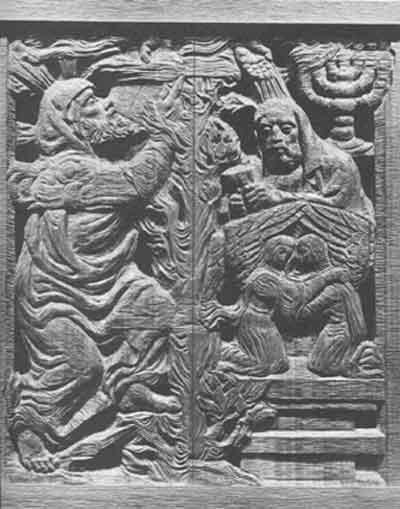
The photograph above is of the doors of the Holy Ark of Temple Israel in Charleston, West Virginia. They were created by Milton Horn in 1960 and their theme is Halakha and Aggada (Jewish law and legend).
On the left, the barefoot Moses reaches up to receive the Tablets of the Law, emerging from an open book. On the right, Bezalel is surrounded by his creations: the Tabernacle’s vessels, the Ark of the Covenant and the cherubs before him and the Menorah behind him. A divine hand imparts to him the spirit of wisdom to fashion these vessels and he grasps in his hands a hammer and a chisel. Between Moses and Bezalel a plant is rising: the Burning Bush on the left and a tree for fashioning the Tabernacle vessels on the right.
Bezalel and Moses, the artist and the thinker, represent the two essential components of Jewish life, aggada and halakha: imagination and careful deliberation.
In Horn’s doors, the roles of the legislator and of the artist are distinct. In Scottish artist Benno Schotz's statue, Moses performs both roles.

According to Exodus 34:1, God commanded Moses to chisel new tablets to replace the first tablets that he had smashed during the incident of the Golden Calf. The root פס"ל (“sculpt”), is very rare in the Bible, appearing only here (and in the verse that describes the fulfillment of the command) and in Exodus 20:4 – in a verse of the Ten Commandments that seems to prohibit sculpture.
(ד) לֹֽ֣א־תַֽעֲשֶׂ֨ה־לְךָ֥֣ פֶ֣֙סֶל֙ ׀ וְכׇל־תְּמוּנָ֔֡ה אֲשֶׁ֤֣ר בַּשָּׁמַ֣֙יִם֙ ׀ מִמַּ֔֡עַל וַֽאֲשֶׁ֥ר֩ בָּאָ֖֨רֶץ מִתָּ֑͏ַ֜חַת וַאֲשֶׁ֥ר בַּמַּ֖֣יִם ׀ מִתַּ֥֣חַת לָאָֽ֗רֶץ׃
(4) You shall not make for yourself a sculptured image, or any likeness of what is in the heavens above, or on the earth below, or in the waters under the earth.
In fact, this famous verse does not prohibit all sculpture, but only the creation of objects intended for worship.
As a Jewish sculptor, Schotz may have been intrigued by the verse in Exodus 34 for two reasons: 1) his personal response to traditional Jewish reservations regarding images and 2) his identification with Moses, who is depicted here as a sculptor in the context of his role as the legislator.
The Goal
The picture below is a detail from Michael Sgan-Cohen's painting, Moses.
As is well-known, Moses accomplished his task of bringing the people to the land of Israel, but he himself was not allowed to enter. He was permitted only to see the land from Mount Nebo, on the other side of the Jordan River, where he died and was buried. Usually this event is perceived as a tragedy and even an injustice.
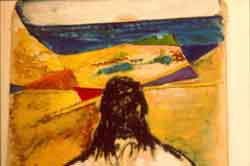
Michael Sgan-Cohen, Moses (detail), 1978
Because the observer is looking from behind Moses’ back, he or she adopts the great leader’s view and emotions. In the distance, the sun is setting over the Mediterranean Sea. The Land of Israel is depicted schematically, as a map that highlights the Sea of Galilee, the Dead Sea, the date palms of Jericho and the bay of Haifa. Beyond that a Star of David frames the map of the land.
As for Moses, the only thing that can be said based on this image is that his hair is long, unruly and still dark, even though he is 120 years old, as we know from the text of Deuteronomy 34.
(ז) וּמֹשֶׁ֗ה בֶּן־מֵאָ֧ה וְעֶשְׂרִ֛ים שָׁנָ֖ה בְּמֹת֑וֹ לֹא־כָהֲתָ֥ה עֵינ֖וֹ וְלֹא־נָ֥ס לֵחֹֽה׃
(7) Moses was a hundred and twenty years old when he died; his eyes were undimmed and his vigor unabated.
Through his hair, however, a face is discernible. Thus, Moses is looking in three important directions: toward the unobtainable future, toward the observer and toward his own past. Through this play with points of view, Sgan-Cohen expresses his own identification with Moses, as a tragic figure.
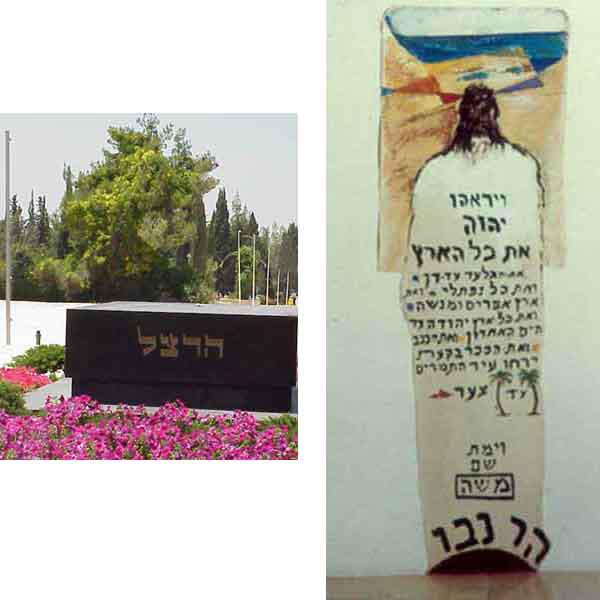
Theodor Herzl's tomb, Jerusalem Michael Sgan-Cohen, Moses
A look at the full scope of Sgan-Cohen's painting reveals a lengthy text written across Moses’ back. It is part of
(א) וַיַּ֨עַל מֹשֶׁ֜ה מֵעַרְבֹ֤ת מוֹאָב֙ אֶל־הַ֣ר נְב֔וֹ רֹ֚אשׁ הַפִּסְגָּ֔ה אֲשֶׁ֖ר עַל־פְּנֵ֣י יְרֵח֑וֹ וַיַּרְאֵ֨הוּ יְהֹוָ֧ה אֶת־כׇּל־הָאָ֛רֶץ אֶת־הַגִּלְעָ֖ד עַד־דָּֽן׃ (ב) וְאֵת֙ כׇּל־נַפְתָּלִ֔י וְאֶת־אֶ֥רֶץ אֶפְרַ֖יִם וּמְנַשֶּׁ֑ה וְאֵת֙ כׇּל־אֶ֣רֶץ יְהוּדָ֔ה עַ֖ד הַיָּ֥ם הָאַחֲרֽוֹן׃ (ג) וְאֶת־הַנֶּ֗גֶב וְֽאֶת־הַכִּכָּ֞ר בִּקְעַ֧ת יְרֵח֛וֹ עִ֥יר הַתְּמָרִ֖ים עַד־צֹֽעַר׃ (ד) וַיֹּ֨אמֶר יְהֹוָ֜ה אֵלָ֗יו זֹ֤את הָאָ֙רֶץ֙ אֲשֶׁ֣ר נִ֠שְׁבַּ֠עְתִּי לְאַבְרָהָ֨ם לְיִצְחָ֤ק וּֽלְיַעֲקֹב֙ לֵאמֹ֔ר לְזַרְעֲךָ֖ אֶתְּנֶ֑נָּה הֶרְאִיתִ֣יךָ בְעֵינֶ֔יךָ וְשָׁ֖מָּה לֹ֥א תַעֲבֹֽר׃
(1) Moses went up from the steppes of Moab to Mount Nebo, to the summit of Pisgah, opposite Jericho, and יהוה showed him the whole land: Gilead as far as Dan; (2) all Naphtali; the land of Ephraim and Manasseh; the whole land of Judah as far as the Western Sea; (3) the Negeb; and the Plain—the Valley of Jericho, the city of palm trees—as far as Zoar. (4) And יהוה said to him, “This is the land of which I swore to Abraham, Isaac, and Jacob, ‘I will assign it to your offspring.’ I have let you see it with your own eyes, but you shall not cross there.”
which describes what Moses saw. But the shape of the text is also reminiscent of a tombstone or obituary notice.
Note also that the highlighted word צער, which in this context denotes a place name, can also be referring to an emotion – ‘distress, sorrow’.
In comparison and contrast, note the tombstone of Theodor Herzl, who similarly did not see the fulfillment of his vision.
For additional images on this subject see TALI Visual Midrash



